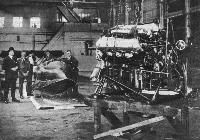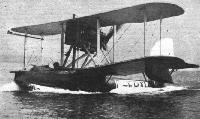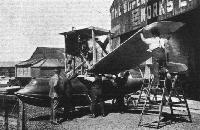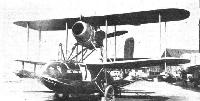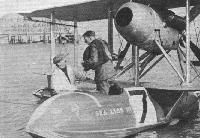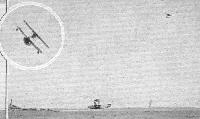
Supermarine. Гоночные самолеты
Большая часть усилий компании "Supermarine" в первое десятилетие ее существования была направлена на создание самолетов для участия в Кубке Шнейдера. Первой такой машиной стал Sea Lion I, построенный на базе гидросамолета N.1B Baby. Последний создавался по техническому заданию N.1B Авиационного департамента Адмиралтейства от 1917 года на одноместный истребитель - летающую лодку. Sea Lion I был маленьким бипланом, получившим свое имя за 450-сильный (336 кВт) ПД Napier Lion с толкающим винтом, установленным на подкосах между крыльями.
В 1922 году компания "Supermarine" снова приняла участие в состязаниях, проводившихся тогда в Неаполе, представив самолет Sea Lion II. Он был разработан на базе одноместного истребителя - летающей лодки Sea King II, и сохранил двигатель Napier Lion своего предшественника. На этом самолете, получившем регистрацию G-EBAH, в гонке одержал победу Генри Байард, показавший среднюю скорость 234,48 км/ч.
Для гонок 1923 года в британском Коусе Sea Lion II доработали, установив на нем 550-сильный (410 кВт) вариант двигателя Lion, а название сменили на Sea Lion III. В гонке он занял третье место, уступив американским гидросамолетам Curtiss CR-3.
<...>
Описание:
- Supermarine. Гоночные самолеты
- Flight, July 1920
The Olympia Aero Show 1920 - Flight, April 1922
THE SUPERMARINE SINGLE-SEATER FIGHTING SCOUT "SEA KING," MARK II.
Фотографии
-
Flight 1940-04 / Flight
Регистрационный номер: G-EALP [3] THE 1919 SCHNEIDER CUP CONTEST: A British entry, the Supermarine "Sea Lion" (Napier "Lion"), piloted by Sq.-Com. Hobbs.
The Sea Lion I flown by Commander Hobbs in the 1910 contest at Bournemouth. The engine was a Napier Lion. -
Мировая Авиация 244
Регистрационный номер: G-EALP [3] Sea Lion I (G-EALP) принимал участие в гонке 1919 года в английском Борнмуте. Гонке помешал туман, и самолет был снят с дистанции после первого круга.
-
Flight 1929-09 / Flight
Регистрационный номер: G-EALP [3] AT BOURNEMOUTH: THIS VIEW SHOWS THE ONE OF FOUR COMPETITORS IN THE 1919 CONTEST STARTING OFF THE PIER. HOBBS ON THE SUPERMARINE "SEA LION" FLYING-BOAT.
-
Flight 1920-07 / Flight
The Supermarine "Sea King," a single-seater flying boat
-
Flight 1922-04 / Flight
THE SUPERMARINE "SEA KING" ("Sea Lion II"): Side view.
-
Flight 1940-04 / Flight
In 1922 appeared the Sea King, a modified version of which took part in that year's Schneider Contest under the name Sea Lion II. Note that the pusher arrangement is still retained.
-
Flight 1922-03 / Flight
A SUPERMARINE SINGLE-SEATER FIGHTING SCOUT AMPHIBIAN: Three illustrations of the "Sea King, Mark I," fitted with 300 h.p. Hispano-Suiza engine. This machine is capable of all the usual tricks of a land aeroplane, being capable of being looped, rolled, spun, etc.
-
Flight 1922-04 / Flight
THE SUPERMARINE "SEA KING" TAXYING: Note the wheels lifted clear of the water.
-
Flight 1929-09 / Flight
PREPARING THE VICTOR: THE HULL OF THE SUPERMARINE "SEA LION" FLYING-BOAT, AND THE NAPIER "LION" ENGINE READY FOR INSTALLATION AT THE SUPERMARINE WORKS AT SOUTHAMPTON.
-
Flight 1922-08 / Flight
THE BRITISH SEAPLANE VICTORY: Matched against the fastest seaplanes in the world, the Supermarine, with Napier Lion engine, piloted by Mr. Biard, has beaten its competitors, and won this year's Schneider race at Naples. As a result, next year's race will be flown in this country. Our photographs show the hull of the Supermarine flying boat and the Napier Lion ready for installation at the Supermarine works, Southampton, and, on the left, the complete machine on the slipways. Inset is a portrait of Mr. Biard, chief pilot of the Supermarine Aviation Works.
-
Flight 1922-08 / Flight
FOR THE SCHNEIDER CUP: Swinging the Napier Lion-engined Supermarine Flying Boat on to the S.S. "Philomel" at Southampton for transhipment to Naples. In the group are Capt. H. J . Field, Mr. Scott-Paine and Mr. Braid. The date for the Schneider Cup was advanced by two weeks, and it was only by the sportsmanlike action of the General Steam Navigation Company in diverting the "Philomel'' to Southampton from her normal course to Naples that the Supermarine boat will be enabled to make a bid at Naples to bring back the Cup to England,
-
Flight 1929-09 / Flight
Регистрационный номер: G-EBAH [7] Для гонок на Кубок Шнейдера 1923 года в Англии был реконструирован Supermarine Sea Lion II с двигателем Lion 525 л.с.(391 кВт), новыми поплавками и фюзеляжем обтекаемой формы. Его обошли американские машины Curtiss CR-3.
Драма в Неаполе - гонки на Кубок Шнейдера. 12 августа 1922г.: если бы Италия выиграла 6-е гонки на Кубок Шнейдера, то приз остался бы у нее навсегда. После предварительных соревнований Франция отозвала две свои летающие лодки CAMS 36, так что остались только британец Генри Биард на Supermarine Sealion II (G-EBAH, фото) и итальянская команда в составе Macchi М7, Macchi М17 и полутораплана Savoia S.51. Летая в команде, три итальянских пилота использовали тактику блокирования противника, особенно в местах поворота на маршруте, чтобы не дать Биарду улучшить его среднюю скорость (241 км/ч) на первом круге. Биард был вынужден приближаться сзади к итальянцам и набирать высоту, чтобы обходить их сверху. Через семь кругов, несмотря на постоянное давление со стороны пилота S.51, Биард выиграл гонку с перевесом всего в две минуты.
The Coupe Schneider: The winning Supermarine, "Sea Lion II," Napier "Lion" engine, at rest on the sea off Naples. -
Flight 1923-09 / Flight
Регистрационный номер: G-EBAH [7] Out for a test: The Supermarine "Sea Lion," Mark II, Napier "Lion" engine, one of the Schneider Cup defenders, taxiing down Southampton Water preparatory to making a test flight piloted by Capt. Biard, winner of the Schneider Cup Race at Naples last year.
-
Jane's All the World Aircraft 1980 / Encyclopedia of Aviation - Aircraft A-Z - v5
Supermarine Sea Lion II winning the 1922 Schneider Trophy contest.
-
Flight 1923-08 / Flight
One of the Schneider Cup defenders: The Supermarine "Sea Lion," with 450 h.p. Napier "Lion" engine, being got ready for her tests at the Southampton works of the Supermarine Company.
-
Flight 1924-05 / Flight
Регистрационный номер: G-EBAH [7] The Supermarine "Sea Lion" is a fighting scout amphibian, with Napier "Lion" engine. It is similar to the Schneider Cup racer of 1923.
-
Flight 1923-10 / Flight
Регистрационный номер: G-EBAH [7] Captain Biard, the pilot, on board the Supermarine "Sea Lion III."
-
Flight 1940-04 / Flight
Регистрационный номер: G-EBAH [7] A view of the Sea Lion III, piloted by Capt. Biard in the 1923 contest held at Cowes. Capt. Biard is in the cockpit.
-
Flight 1929-09 / Flight
Регистрационный номер: G-EBAH [7] The 1923 Schneider Cup Contest: The British representative, which put up a good fight to retain the trophy. The Supermarine "Sea Lion III" (Napier "Lion"), piloted by Capt. Biard, taxi-ing slowly past I the Blackburn "Pellet."
-
Flight 1923-10 / Flight
THREE OF THE COMPETITORS ON SAUNDERS' SLIPWAY ON THE MORNING OF THE RACE: On the left, the Curtiss-Navy No. 3. In the centre, the Supermarine, and on the right, the C.A.M.S. 38
Другие самолёты на фотографии: CAMS CAMS 36 / CAMS 38 - Франция - 1922Curtiss CR / R-6 - США - 1921
-
Flight 1923-10 / Flight
THE MOORING TEST: The six machines in line are, left to right, the Supermarine "SeaLion III," the two American Navy-Curtiss seaplanes, the C.A.M.S. flying boats, and the Latham twin-engined flying boat.
Другие самолёты на фотографии: CAMS CAMS 36 / CAMS 38 - Франция - 1922Curtiss CR / R-6 - США - 1921Latham L-1 / L-2 - Франция - 1923
-
Flight 1929-09 / Flight Advertisements
Supermarine Sea Lion (450 h.p. Napier Lion Engine). Average Speed 146 m.p.h. Winner at Naples 1922.
-
Flight 1923-10 / Flight
THE SCHNEIDER CUP RACE: Capt. Biard, on the Supermarine "Sea Lion III," gets away, just as the American Navy-Curtiss No. 4 (Rittenhouse) rounds the mark boats after finishing his first lap. Inset shows Capt. Biard turning.
Другие самолёты на фотографии: Curtiss CR / R-6 - США - 1921
-
Мировая Авиация 43
Регистрационный номер: G-EBAH [7] Драма в Неаполе - гонки на Кубок Шнейдера. 12 августа 1922г.: если бы Италия выиграла 6-е гонки на Кубок Шнейдера, то приз остался бы у нее навсегда. После предварительных соревнований Франция отозвала две свои летающие лодки CAMS 36, так что остались только британец Генри Биард на Supermarine Sealion II (G-EBAH) и итальянская команда в составе Macchi М7, Macchi М17 и полутораплана Savoia S.51. Летая в команде, три итальянских пилота использовали тактику блокирования противника, особенно в местах поворота на маршруте (рисунок), чтобы не дать Биарду улучшить его среднюю скорость (241 км/ч) на первом круге. Биард был вынужден приближаться сзади к итальянцам и набирать высоту, чтобы обходить их сверху. Через семь кругов, несмотря на постоянное давление со стороны пилота S.51, Биард выиграл гонку с перевесом всего в две минуты.
-
Flight 1920-07 / Flight
SOME SUPERMARINE DETAILS: Right, the wing tip float of the "Sea King," and on the left the tail of the "Sea King"
-
Flight 1922-04 / Flight
THE SUPERMARINE "SEA KING": General arrangement and details of the retractable undercarriage.
-
Flight 1922-04 / Flight
THE SUPERMARINE "SEA KING": The pilot's back rest hinges down to form a step so as to facilitate reaching the starting handle of the engine. The starting magneto is housed in the fairing on the port side. On the starboard side is the petrol filler cap.
-
Flight 1922-04 / Flight
THE SUPERMARINE "SEA KING": The rear step is "ventilated" by a tube running through the hull.
-
Flight 1922-04 / Flight
Sketch showing general arrangement of tail of the Supermarine "Sea King." The tail plane is negatively cambered.
-
Flight 1922-04 / Flight
The very substantial combined tail skid and water rudder of the "Sea King."
-
Flight 1922-04 / Flight
Supermarine S.S. Amphibian Flying Boat 300 hp Hispano-Suiza Engine
- Фотографии








